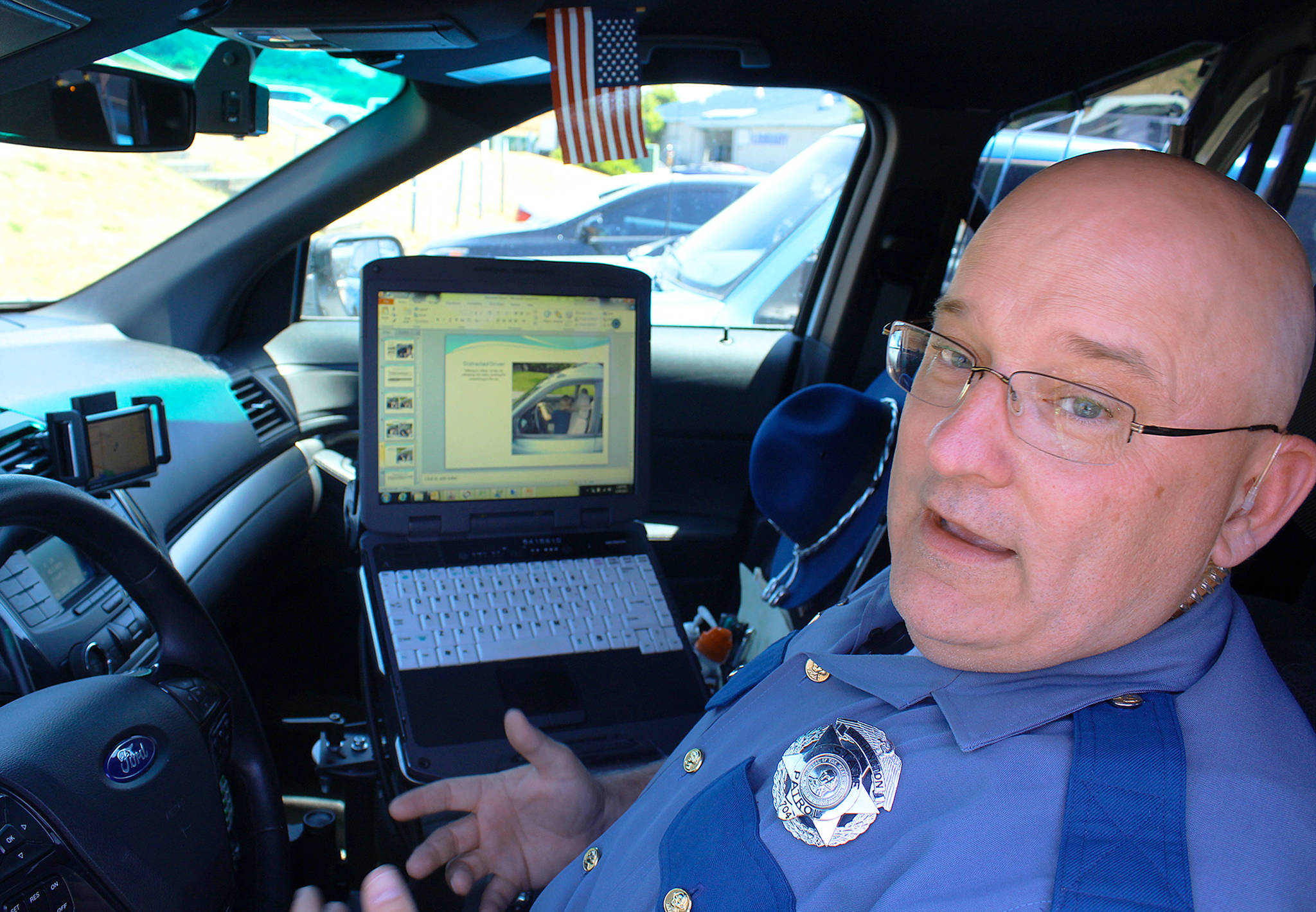Put down your phone and just drive.
That advice becomes law Sunday under the state Driving Under the Influence of Electronics Act. Washington drivers using any electronic device while behind the wheel — even when parked at a stoplight — could result in a fine of $136. A second citation within five years of the first one costs $236.
Additionally, drivers can be cited for “dangerous distracted driving” if they are stopped for unsafe driving and found to be distracted by eating, shaving, reading a newspaper, or other activities commonly witnessed by law enforcement.
“There’s all kinds of things out there that distract people from driving,” says State Trooper Mark Francis, who patrols Whidbey Island.
“People think it’s only cell phones. But if I see a driver go over the center line and stop her and there’s a dog on her lap, I will be able to cite her for dangerous distracted driving,” Francis said. “It’s a new law for us. Before we’d have to cite for negligence in the secondary degree.”
The tougher measures were to go into effect in 2019 after being passed by the Legislature earlier this year but the governor bumped up the start date, saying it was too important to wait.
From 2014 to 2015, Washington state experienced a 32 percent increase in the number of deaths resulting from distracted driving.
“Put the cell phones down, preserve life,” Gov. Jay Inslee said on the steps of the Capitol in Olympia earlier this week. “When you are driving with a cell phone, you are a more dangerous driver than if you are driving drunk with a .08 blood alcohol level.”
Another change: unlike current law, which exempts cell phone violations for being reported to insurance companies, all violations will now be available to insurance companies.
Under the measure, “the minimal use of a finger” to activate, deactivate, or initiate a function of a personal electronic device while driving will still be allowed. That’s being referred to as “one swipe allowed.”
The current law, written in the age of flip phones, prohibits texting and holding a phone to your ear while driving.
The new law is a broad sweep aimed at dozens of devices and thousands of apps — and distractions — now available at people’s fingertips.
“Under the old cell law, drivers could say they were just looking at music on their smartphone, and there was no way to disprove it,” Francis explained. “Now, they can’t have the phone in their hand.”
A grace period of about six months will allow drivers to adjust to the new law; troopers will give out warnings instead of tickets.
Drivers can also get a $99 ticket for other types of distractions if it interferes with safe driving and the vehicle is stopped for another traffic offense. Driving while listening, and driving while talking to people not in the car, is still legal via the high tech combo of wi-fi and built-in hands-free devices, such as BlueTooth.
But hands free doesn’t mean accident free.
“Statistics show it is still dangerous because drivers are still distracted by conversations” with people not in the vehicle, Francis said. One reason is a disembodied voice isn’t seeing what the driver is seeing and keeps on yammering through near collisions and road hazards.
Researchers have proven that looking away from the road a few seconds and the brain overload of listening or multitasking are as dangerous as driving drunk.
Drivers are three-to-four times more likely to be in a crash when talking on a phone, and 23 times more likely to crash while entering information into a phone.
A National Safety Council review of the science concluded that “hands-free devices offer no safety benefit when driving.”
And a study by the AAA Foundation for Traffic Safety says that even built-in, voice-activated systems can impair brain focus for up to 15 to 27 seconds.
Changing people’s behaviors is at the heart of the new laws. Many cite seat belts as going through a similar evolution of no laws to accepted standard practice.
“Who is most likely to put on their seat belt first in a car? Kids, young adults because they never knew a time when seat belts weren’t the law,” points out Island County Sheriff Mark Brown. “Now, somehow we’ve come to associate getting into a car is the time to check your phone messages, your emails, your Facebook — it’s become the culture. That’s all kids know. That behavior will be tough to change. Adults will have to set the example.”
Spotting people talking on cell phones or checking their many apps isn’t as easy on Whidbey Island’s main road as it is in urban areas and double-lane highways, Francis admitted.
“It’s easier to spot them on I-5 because of multiple lanes,” he said. “And obviously when we’re driving through cities, we can pull up next to people and see them talking on their phones.”
If conversations are urgent, drivers are encouraged to pull over and stop their car. Devices can also still be used for emergency calls.
The best advice is easy, says State Trooper Dave Martin, who’s been patrolling Whidbey’s roads for 13 years.
“Let’s focus on driving, on getting from Point A to Point B.”
INFO BOX
July 23: Put down your phone and just drive. It’s the (new) law.
• Drivers may not use hand-held cell phones or other hand held electronic devices while they are driving or stopped in traffic.
• Hands-free use, such as through Bluetooth, is allowed as is a single touch to start a function.
• Drivers can use hand held devices when they are pulled over out of the flow of traffic and for emergency calls.
• First ticket costs at least $136, second ticket within five years: $272 or more. Drivers can also be cited for dangerous distracted driving as a secondary offense, costing $99.



